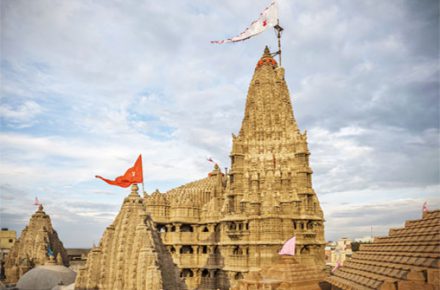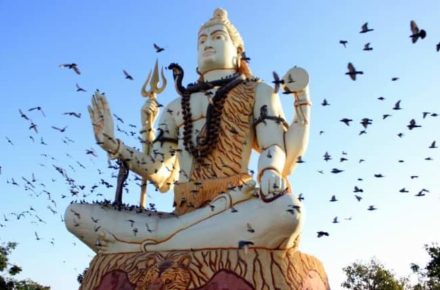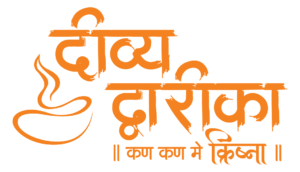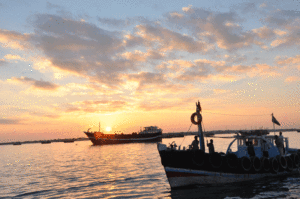Dwarka Nagari – Popular Myths
(1) Dwarka was considered as Capital at Shree Krishna hile Bet Dwarka as residence. Shree Krishna used to conduct his religious assembly at Dwarka.
(2) Gopi Lake is located 14 kms. A way from Dwarka. Soil of Gopi talav is yellow in color while it is extremely smooth. There is myth that after leaving ‘ Vruj’ , Krishna never gone back to ‘Vruj’. During Krishna’s Childhood, he played ras leelas many times with gopies (young female inhabitant of Vruj). They traveled from ‘Vruj’ to Dwarka, to meet Shree Krishna. They after playing Ras Leelas again with Shree Krishna, on night of ‘Sharad Purnima’, they offered their lives to soil of this land and hence this land has become popular as ‘Gopi Talav’.
(3) Rukhmini Temple (Temple one of Shree Krishna’s Patranis), is located 2 kms a away from Dwarka There is a myth associated with it once Krishna and Rukhmini went to ‘Durvasha rushi’ to invite him at Dwarka. He was agreed on the condition that they (Krishna & Rukhmini) have to carry the chariot instead of any animal. Krishna & Rukhmini happily agreed to do so. While driving the chariot, Rukhmini became thirsty. Then Krishna stopped the chariot and made water of Holy River Ganga. ‘Durvasha’ annoyed by the action and curse Rukhmini to stay away from Shree Krishna Hence Rukhmini temple is located 2 kms. Away from Dwarka’s Jagat Mandir.
Airlift technique was adopted for digging within the caisson to dig trenches on the sides of structures. All drawings were prepared underwater.

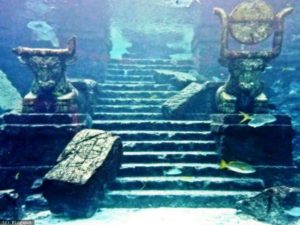 The Fourth Expedition in April 1986 found that the top stones of the masonry of the structures were disturbed by current and swell. In fact they lay under a thick mantle of sediment held by vegetation. The overburden was removed and trenches were dug on either side to expose at least a couple of courses of masonry. The Fourth Expedition, though of very short duration, could discover four 3-holed stone anchors of the type found in Syria and Cyprus and used during the 14th – 12th century BC. A large one is damaged but it was retrieved carefully. As the sea became very rough by the end of December the Expedition had to leave hurriedly. The experience of working in different months from October to May in four expeditions has shown that the proper season for exploration is from mid-November to mid-February even though in November and December heavy snow fall in Kashmir brings severe cold wind to Kachchh- Saurashtra and the sea becomes suddenly choppy. For instance, on 13th December 1986 the sea became so rough that waves 5 to 6 m high were breaking 200 m from shore, In the Third and Fourth Expeditions probing with an iron rod indicated locations of structures in the sea and vegetation was removed. The Fifth Expedition was highly successful in uncovering a massive bastion and fort walls besides three other structures — all in situ . Hundreds of architectural members are lying loose in the seabed within 800 m of SN temple. Five structures in situ were uncovered after removing vegetation and sand overlying the structures with an airlift or air jet. In several places small trenches had to be dug along the margin of structures with an air jet to trace a few courses of the masonry.
The Fourth Expedition in April 1986 found that the top stones of the masonry of the structures were disturbed by current and swell. In fact they lay under a thick mantle of sediment held by vegetation. The overburden was removed and trenches were dug on either side to expose at least a couple of courses of masonry. The Fourth Expedition, though of very short duration, could discover four 3-holed stone anchors of the type found in Syria and Cyprus and used during the 14th – 12th century BC. A large one is damaged but it was retrieved carefully. As the sea became very rough by the end of December the Expedition had to leave hurriedly. The experience of working in different months from October to May in four expeditions has shown that the proper season for exploration is from mid-November to mid-February even though in November and December heavy snow fall in Kashmir brings severe cold wind to Kachchh- Saurashtra and the sea becomes suddenly choppy. For instance, on 13th December 1986 the sea became so rough that waves 5 to 6 m high were breaking 200 m from shore, In the Third and Fourth Expeditions probing with an iron rod indicated locations of structures in the sea and vegetation was removed. The Fifth Expedition was highly successful in uncovering a massive bastion and fort walls besides three other structures — all in situ . Hundreds of architectural members are lying loose in the seabed within 800 m of SN temple. Five structures in situ were uncovered after removing vegetation and sand overlying the structures with an airlift or air jet. In several places small trenches had to be dug along the margin of structures with an air jet to trace a few courses of the masonry.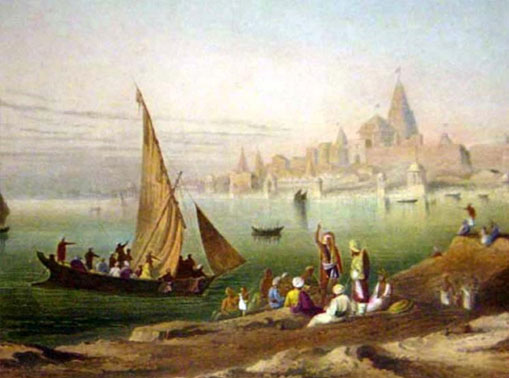 According to Hindu tradition still extant, the earliest known conqueror of Okhamandal was Shri Krishna, called also Ranchodji, the eight incaranation of Vishnu, Who after his seventeenth battle with Jara Sangh, king of Magadh Desh, fled from Mathura, and eventually arrived with his army at Okhamandal which he subjected after a hard struggle with the Kalas. Shri Krishna established his capital at Dwarka on the bank of the Gomti Creek.
According to Hindu tradition still extant, the earliest known conqueror of Okhamandal was Shri Krishna, called also Ranchodji, the eight incaranation of Vishnu, Who after his seventeenth battle with Jara Sangh, king of Magadh Desh, fled from Mathura, and eventually arrived with his army at Okhamandal which he subjected after a hard struggle with the Kalas. Shri Krishna established his capital at Dwarka on the bank of the Gomti Creek.